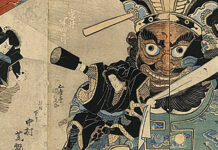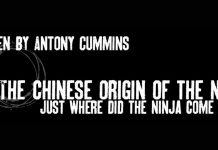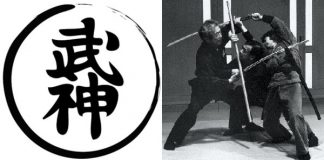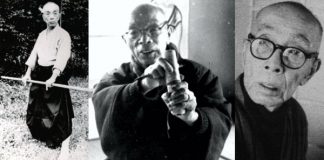This is a new 6-part Docu-Drama on Netflix. It provides a glimpse into the lives and times of the three great unifiers of Japan during the ”Sengoku Jidai” (“Warring States Period,” 1467-1615). Oda Nobunaga, Toyotomi Hideyoshi and Tokugawa Ieyasu. If you enjoy samurai movies during the Japanese age of feudalism, you may enjoy it.
This series was advertised as the Japanese version of Game of Thrones — LOL, hardly, you can’t cover too much material in an under-budgeted show of 6 episodes. Personally I was disappointed, it’s like being invited to a 10-course dinner, but when you arrive they only give you a hamburger. Many important aspects of this period were omitted or ignored.
Having visited, studied and lived in Japan several times and practiced a variety of martial arts there I have some knowledge about feudal Japan and the samurai. However I’m not an expert historian on the subject. The historians making comments during the show were supposedly experts, but they were mistaken on more than a few items. I have posted links at the end of this review (Part II) for source materials to Antony Cummins, a researcher, writer and expert on the ninja and samurai. He also made an excellent chapter-by-chapter analysis of the Docu-Series.
I present my comments here, my perspective comes from my studies and personal experiences. This is my supplement to the series, I added a much needed background on this complicated subject matter.
First Some Background — The Chinese Influence On Japan
The name “Warring States” was borrowed from the Chinese Warring States period (475-221 BC) more than a thousand years before. The Japanese admired the Chinese and sought to parallel China for credibility. During China’s Sui and Tang Dynasty. China greatly influenced Japan and helped transform it into a cultured civilization. Before the Chinese influence you could accurately say Japan was a country of backwater hicks.
Major Chinese contributions to Japanese civilization included: painting, sculpture, architecture, science, medicine, religion, philosophy, written language, systems of royal titles and ranks, irrigation systems and planning, temple building, government bureaucracy, centralized government, city planning, music, clothing/fashions, kabuki, tea ceremony, court dancing, war arts and martial arts.
Samurai – The Backstory
The Bushido Code was a modern creation, a fanciful idealization of how a true samurai should act, ethically and morally. However it was written after Japan was unified. This was a time when samurai no longer fought wars. Inasmuch as samurai were reputed to be brave and fearless warriors there was also a dark side – extreme cruelty and violence, the taking of heads, the slaughter of women and children and roadside killings to name a few.
Roadside killings were a popular pastime, samurai would kill merchants and farmers wherever and whenever they felt like. The goal was to kill one thousand people, believing that would generate health and infuse their swords with divine power. It was said that the third shogun, Tokugawa Iemitsu often sneaked out of his castle to test his sword on innocent passerbys.
Weapons Used on the Battlefield
There is a common misperception that samurai fought their battles with only swords, nothing could be further from the truth. Organized battles usually incorporated pikes, halberds (Naginata), spears, archery and in this period the arquebus and cannons. If a battle was lost, the losing side would run away – often to be chased and cut down with spears and swords by the victors.
Size of Battles in Inter-Clan Warfare
With a few exceptions (including Sekigahara) warfare between clans were small affairs compared with the great Chinese and European battles. There were no great siege engines or grand strategies to speak of.
What Did Samurai Actually Look Like?
In general, samurai weren’t very impressive looking, many were usually between 5’ to 5’-2” tall and petite. I once visited a Japanese museum that displayed feudal armor and overheard a child tell his mother “Look, they made armor for kids too – His mother looked at the description and told him, no this was the armor that samurai wore.” Yes, of course there were exceptions. Miyamoto Musashi for example was recorded to be above average height, around 5’-10.”
BTW: Did anyone notice that there were that a number of extras, Hawaiians/Samoans appeared in several scenes – I suppose the directors thought the viewers are too dumb to tell the difference?
Nobunaga – The First Great Unifier
The program begins with the introduction of Oda Nobunaga. They show him as a wild and uncouth man – probably true when he was young. You’ll notice he doesn’t have a “Chonmage” (a topknot), but as he matured he adopted it’s use.
Where’s My Chonmage?
This hairstyle dates back to the Heian era (794-1185). During this time nobles (in Kyoto) wore special caps on top of their hair (this style originated in China). This look was eventually adopted by samurai as a hairstyle and eventually came to represent the samurai class. It can still be seen today on sumo wrestlers.
*Did you notice there wasn’t a single samurai in the series wearing the Chonmage; that would have been highly unlikely since most samurai did during this time. I guess the actors weren’t being paid enough to shave their heads.
Hey – Where Did All the Sashimono Go?
Sashimono were war banners that were worn on the backs of samurai and ashigaru (common soldiers) to identify friend or foe, they also identified which clan they belonged to. There must have been a Sashimono union workers strike because I don’t recall seeing any in the show. To see a good representation of these banners, do a search for the following Japanese movies: Ran, Kagemusha, and Heaven and Earth.
Historians Perpetuate the Myth of the Samurai Sword
One of the commentators stated that the Japanese sword was the finest sword ever made in history – RUBBISH. It was a good sword but there were many good swords from other cultures as well. The Ulfberht sword developed by Saxons and Vikings were made with the same layering/laminating technology that the Japanese used but was invented 600 years earlier. European’s also had access to better iron ore with fewer impurities than were used in Japan (one source of iron ore came from India).
In Europe many swords were more flexible than Japanese swords due to better metals, they were more like spring steel and therefore had far less issues with breakages. If you go to Japanese antique shops today that specialize in weapons from the “Sengoku Era” you will come across many broken swords. But even the broken ones are still extremely expensive – they’re antiques.
Nobunaga Attacks the Iga Stronghold
The Iga was the name of a ninja group. Ninja is a modern term, the proper name was Shinobi.
*This episode was grossly misrepresented – I refer you to the analysis by Antony Cummins at the bottom of Part II.
The Battle of Nagashino – The End of the Takeda
This is where Nobunaga essentially annihilated the Takeda clan. Many people incorrectly assume Nobunaga fought Takeda Shingen, one of the greatest commanders of the era, however Shingen died 9 years previous to the battle. Takeda’s son Katsuyori was an experienced soldier however a failure as a tactician. He lost the battle, and most of his army was killed and he retreated to his castle with a handful of retainers. Some scholars believe that if Shingen were still alive at that time, the battle may have ended differently. Eventually Nobunaga besieged Takeda’s castle and executed the entire Takeda lineage.
Nobunaga’s Strategies & Tactics
Nobunaga was a brilliant tactician and commander, he used tactics that were unusual for the time. He was the first commander to incorporate large scale rifle-fire (arquebus) against an enemy, alternating gun-fire with archers. This was probably influenced by the Jesuits who were familiar with the European practice of alternating rows of musketeers to shoot continuous volleys.
Resources – Antony Cummins
*Historian Antony Cummins Reviews “Age of the Samurai”
*Historian Antony Cummins discusses Nobunaga’s Attacks on the Iga (Ninja) Stonghold
*Antony Cummins Website
Ninja Historian Reviews Age of the Samurai Episodes
Additional Information – WR
Defensescience.com
Defensescience@gmail.com





